A) C0.
B) C1.
C) C2.
D) C1 - C0.
E) C2 - C1.
Correct Answer

verified
Correct Answer
verified
Multiple Choice
Inventory levels unexpectedly rise and as a result firms reduce the level of production. Which of the following is consistent with these two occurrences?
A) TP is greater than TE.
B) TP is less than TE.
C) TP is equal to TE.
D) TP is equal to TE minus the rise in inventories above the optimum inventory level.
E) none of the above
Correct Answer

verified
Correct Answer
verified
Multiple Choice
Exhibit 10-4
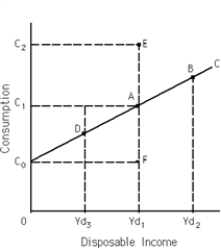 -Refer to Exhibit 10-4. Marginal propensity to consume is equal to
-Refer to Exhibit 10-4. Marginal propensity to consume is equal to
A) AF divided by C0A.
B) C0A divided by AF.
C) AF divided by C0F.
D) C0F divided by AF.
E) none of the above
Correct Answer

verified
Correct Answer
verified
Multiple Choice
The answer is: 1/(1 - MPC) . What is the question?
A) What is the marginal propensity to save?
B) What is the efficiency wage model?
C) What does consumption equal if the economy is in equilibrium?
D) What is the multiplier?
E) What does disposable income equal if the economy is in equilibrium?
Correct Answer

verified
Correct Answer
verified
Multiple Choice
In the Keynesian analysis of changes from one Real GDP level to another, which of the following plays a critical role?
A) changes in prices
B) the relationship between optimum inventory levels and current inventory levels
C) the long-run aggregate supply (LRAS) curve
D) the relationship between total expenditures (TE) and the aggregate demand (AD) curve
E) none of the above
Correct Answer

verified
Correct Answer
verified
Multiple Choice
Exhibit 10-9
 -Refer to Exhibit 10-9. What is the value of the marginal propensity to save (MPS) that would correctly fill in blank (A) and the multiplier that would correctly fill in blank (B) ?
-Refer to Exhibit 10-9. What is the value of the marginal propensity to save (MPS) that would correctly fill in blank (A) and the multiplier that would correctly fill in blank (B) ?
A) 0.20; 5
B) 0.08; 8
C) 0.08; 12.5
D) 0.05; 0.95
Correct Answer

verified
Correct Answer
verified
Multiple Choice
Exhibit 10-2
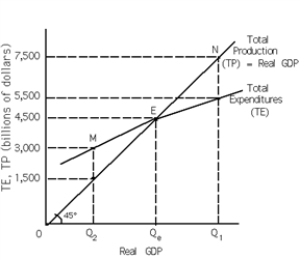 -Refer to Exhibit 10-2. If autonomous consumption increases, the TE curve will shift ____________ and the new level of equilibrium Real GDP will be ___________ than $4,500.
-Refer to Exhibit 10-2. If autonomous consumption increases, the TE curve will shift ____________ and the new level of equilibrium Real GDP will be ___________ than $4,500.
A) downward; greater
B) downward; less
C) upward; less
D) upward; greater
Correct Answer

verified
Correct Answer
verified
Multiple Choice
Which of the following statements is true?
A) When TP = TE (total production = total expenditures) , the economy is necessarily producing Natural Real GDP.
B) When TP is greater than TE, inventory levels unexpectedly fall.
C) When TE is greater than TP, inventory levels unexpectedly rise.
D) b and c
E) none of the above
Correct Answer

verified
Correct Answer
verified
Multiple Choice
Which of the following is not an aspect of Keynesian economics?
A) Wages and prices tend to be inflexible downward.
B) Supply does not necessarily generate its own demand.
C) The interest rate is important in determining the level of investment, but not as important as other variables.
D) Unemployment above natural unemployment is always a brief and temporary phenomenon.
Correct Answer

verified
Correct Answer
verified
Multiple Choice
When there is economy-wide equilibrium, there is a tendency for
A) total output to rise.
B) total output to fall.
C) total output to remain unchanged.
D) prices to fall.
E) prices to rise.
Correct Answer

verified
Correct Answer
verified
Multiple Choice
The closer the aggregate supply curve is to being horizontal, the
A) greater the resulting change in Real GDP for a given change in autonomous spending.
B) smaller the resulting change in Real GDP for a given change in autonomous spending.
C) larger the multiplier.
D) smaller the multiplier.
E) a and c
Correct Answer

verified
Correct Answer
verified
True/False
In Keynes' view, labor unions would resist wage cuts, but individual employees would go along with wage cuts initiated by his/her employer.
Correct Answer

verified
Correct Answer
verified
Multiple Choice
Exhibit 10-6
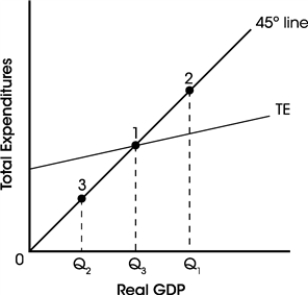 -Refer to Exhibit 10-6. If investment increases, it follows that
-Refer to Exhibit 10-6. If investment increases, it follows that
A) the TE curve will shift upward, possibly passing through point 2.
B) the TE curve will shift downward, possibly passing through point 3.
C) the TE curve will not change but the economy will move from point 1 to point 3.
D) the TE curve will not change but the economy will move from point 1 to point 2.
E) At the new equilibrium position, Real GDP will necessarily be Q1.
Correct Answer

verified
Correct Answer
verified
Multiple Choice
Exhibit 10-8
 -Refer to Exhibit 10-8. The marginal propensity to save (MPS) is
-Refer to Exhibit 10-8. The marginal propensity to save (MPS) is
A) 0.90.
B) 0.10.
C) 0.80.
D) 0.20.
E) 5.00.
Correct Answer

verified
Correct Answer
verified
Multiple Choice
Exhibit 10-1
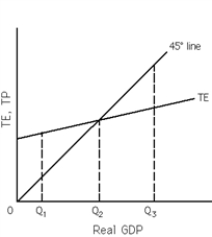 -Refer to Exhibit 10-1. At Q3, there is a tendency for Real GDP to
-Refer to Exhibit 10-1. At Q3, there is a tendency for Real GDP to
A) rise.
B) fall.
C) remain unchanged.
D) There is not enough information to answer this question.
Correct Answer

verified
Correct Answer
verified
True/False
A change in autonomous spending leads to an even greater change in total spending through the multiplier process.
Correct Answer

verified
Correct Answer
verified
Multiple Choice
If income rises from $10,000 to $10,600 and consumption rises from $9,100 to $9,622, the marginal propensity to save (MPS) is
A) 0.13.
B) 0.87.
C) 0.25.
D) 0.10.
Correct Answer

verified
Correct Answer
verified
Multiple Choice
When the MPC = 0.75, the multiplier is
A) 0.25.
B) 1.33.
C) 2.50.
D) 4.00.
E) 5.00.
Correct Answer

verified
Correct Answer
verified
Multiple Choice
Exhibit 10-5
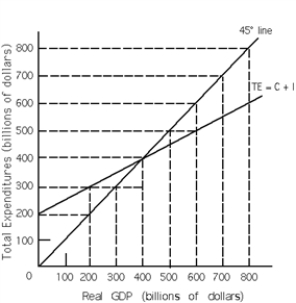 -Refer to Exhibit 10-5. When TE is $300 billion, what will firms most likely firms do next?
-Refer to Exhibit 10-5. When TE is $300 billion, what will firms most likely firms do next?
A) Firms will increase production to increase inventories to their optimum levels.
B) Firms will neither increase nor decrease production since the economy is in equilibrium.
C) Firms will cut back production to reduce inventories to their optimum levels.
D) It is impossible to determine what firms are likely to do based on this information.
Correct Answer

verified
Correct Answer
verified
Multiple Choice
Exhibit 10-5
 -Refer to Exhibit 10-5. When TE is $300 billion, what happens to inventories?
-Refer to Exhibit 10-5. When TE is $300 billion, what happens to inventories?
A) Inventories are at their optimum levels.
B) Inventories will fall, then rise above their optimum levels.
C) Inventories will fall below optimum levels.
D) Inventories will rise above optimum levels.
Correct Answer

verified
Correct Answer
verified
Showing 181 - 200 of 200
Related Exams